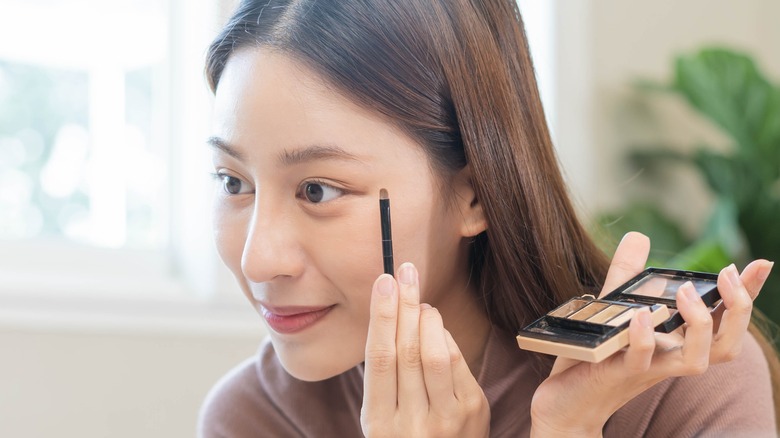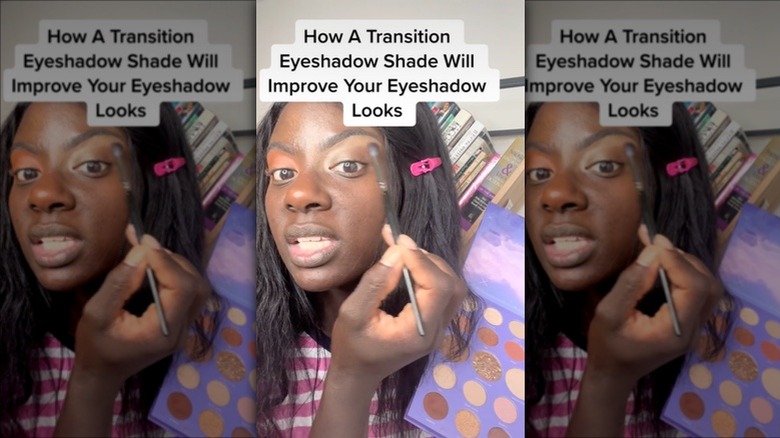Does Your Eyeshadow Look Need A Transition Shade, And If So, How Can You Choose One?
The purpose of eyeshadow is not just to add color to your eyes and the surrounding area, but also to enhance your natural creases and contour them to perfection. That's why we typically use brighter colors along the bottom of our brows and darker colors on or below the creases. The trademark of expertly done eyeshadow is how well it's blended in.
Whether you are going for a multicolored look or a nude one, you need to know how to blend contrasting eyeshadow colors into each other without looking like Ronald McDonald's long-lost sibling. This is where transition shades come in. A transition shade is pretty self-explanatory. Essentially, it's the color you use on your crease or just above it for a seamless balance between your main eyeshadow color, which goes on your eyelid, and your under-brow color.
Transition shades blend two colors together to make them mesh more naturally. Without a transition shade, your eyeshadow can come off looking pretty unfinished and off, especially if you're using a bold color on your lids like blue or black. While you may not always need a transition shade, they do come in handy from time to time. There's also a simple way to tell if you have to use one, and how to do it properly.
How to choose the perfect transition shade
There are so many different skin shades, but we are all variations of brown. This means that the transition shade is usually going to be the shade of brown that matches your skin tone or a couple of shades off. Ultimately, the look you're trying to create will influence what shade you use, whether you're doing subtle glam, or going for a bolder, dramatic beat. It will also determine if you need a transition shade at all.
As TikTok creator @miamissdria explains, "You want to use a shade that's closer to your natural skin tone so that the two shades that you do use will just flow into each other and create a beautiful gradient." If you're unsure about whether or not you should use a transition color for your eyeshadow, consider the colors you are aiming to merge and think about how they would look against your skin.
For instance, if you're doing a soft glam look with neutral tones, you can probably skate by not using a transition color. However, if you are using heavily contrasting or especially bold colors, then the answer is always a definite "yes."
Blending the transition shade properly is crucial
Once you've determined if your eyeshadow look needs a transition shade, it's time to choose the one that's most appropriate for it. Usually, this will be a color close to the shade of your skin. However, the shade depends heavily on the colors you decide to use on your lid. The idea is to make the eyeshadow fall in line with your natural tone without looking out of place so trust your artistic instincts.
According to YouTube beauty influencer Alexandra Anele, the first thing you want to do is prime your eyes. You can use some eyeshadow primer or your favorite concealer to do this. If you're going with concealer, make sure to use the tiniest amount. Next, grab some of the transition color with your brush and tap or flick the brush to get rid of excess makeup. Anele emphasizes that this is so your initial application doesn't come on too strong and overwhelm everything else.
Then, she applies the shade just above the crease and blends it in using circular motions and swift back-and-forth swipes. If you want more definition, add more of the transition shade to your crease. A cool hack Anele offers is that if you don't have a good transition shade on your palette, a great alternative would be using your contour shade or even your bronzer. Once you've blended your transition shade in, design your main eyeshadow however you want, and voilà!

